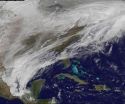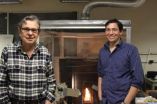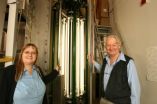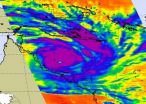(Press-News.org) Nacre, commonly known as mother-of-pearl, is the iridescent material lining many mollusk shells. It is part of a two-layer armor system that protects the animal from predators. The brittle outer layer of the shell absorbs the initial impact, but is prone to cracking. To prevent these cracks from catastrophically propagating through the shell to the animal itself, the nacreous layer is surprisingly strong and tough, with outstanding crack arresting properties. Thus it acts as a lining to maintain the integrity of the shell in the event of cracking of the outer layer.
"What makes this natural material unique is that it is composed of relatively weak constituents," said Owen Loh, a graduate student at Northwestern University. At the microscale, brittle calcite tablets are stacked in a brick-and-mortar-like structure with thin layers of biopolymer lining the interfaces between tablets. This results in a material that well outperforms its individual constituents. For example, the toughness of nacre is orders of magnitude greater than that of the tablet material itself. In addition, nacre is at once strong and tough, a combination that is generally mutually exclusive in engineering materials.
As a result, nacre has been the object of significant interest within the materials community and serves as a model after which numerous man-made composite materials are designed. This includes composites for light-weight armor systems and structural elements in transportation and aerospace applications.
Nacre's outstanding performance has long been attributed to its brick-and-mortar microstructure. However, the specific attributes of this hierarchical structure, which contribute to the toughness of nacre, have been the subject of debate. As a result, efforts to translate deformation mechanisms observed in nacre into man-made composite materials have been widespread but mostly unsuccessful.
In a paper published online in the journal Nature Communications, Horacio Espinosa, the James N. and Nancy J. Farley Professor in Manufacturing and Entrepreneurship at the McCormick School of Engineering and Applied Science at Northwestern, Loh and colleagues report the identification of specific characteristics of the material microstructure that enable its outstanding performance. By performing detailed fracture experiments within an atomic force microscope, the group was able to directly visualize and quantify the way the tablets slid relative to each other as the material is deformed.
The group previously found that the tablets are not perfectly flat but instead have an inherent waviness in their surfaces. As a result, they tend to interlock as they slide relative to each other, spreading damage and dissipating energy over large areas. "We published these results before but it took atomic scales experiments to confirm our hypothesis on the origin of toughness in these biomaterials," Espinosa said.
The group then applied the findings to the design of artificial composites. "We took what we learned from natural nacre and designed a scaled-up artificial composite material with an interlocking tablet structure," said Pablo Zavattieri, a co-author of the paper and assistant professor of civil engineering at Purdue University. "By applying nacre's highly effective toughening mechanism to this material, we were able to achieve a remarkable improvement in energy dissipation."
The findings have important implications for future design of high-performance composite materials. "We believe these findings may hold a key to realizing the outstanding potential of nanocomposites," Espinosa said. "While carbon nanotubes and other nanoscale reinforcements utilized in these materials have unprecedented properties, their performance has yet to be translated to bulk composites. By implementing toughening mechanisms such as those we found in natural nacre, we may be able to achieve this."
###In addition to Espinosa, Loh and Zavattieri, the paper was co-authored by Allison Juster, Felix Latourteand David Gregoire.
Synthetic materials that behave like mollusk shells
2011-02-03
ELSE PRESS RELEASES FROM THIS DATE:
GSA Bulletin highlights: New research posted Jan. 21-28
2011-02-03
Boulder, CO, USA - GSA Bulletin is now regularly posting pre-issue publication content -- finalized papers that have not been assigned to an issue but are not under embargo. GSA invites you to sign up for e-alerts and/or RSS feeds to have access to new journal content the minute it is posted online. Go to http://www.gsapubs.org/cgi/alerts and enter your e-mail address to manage your subscriptions.
Faulted terrace risers place new constraints on the late Quaternary slip rate for the central Altyn Tagh fault, northwest Tibet
Ryan D. Gold et al., Dept. of Geology, ...
Migraine surgery offers good long-term outcomes
2011-02-03
Surgery to "deactivate" migraine headaches produces lasting good results, with nearly 90 percent of patients having at least partial relief at five years' follow-up, reports a study in the February issue of Plastic and Reconstructive Surgery®, the official medical journal of the American Society of Plastic Surgeons (ASPS).
In about 30 percent of patients, migraine headaches were completely eliminated after surgery, according to the new study, led by Dr. Bahman Guyuron, chairman of Plastic and Reconstructive Surgery at University Hospitals Case Medical Center and Case ...
Researchers lead search for better drug-addiction treatments
2011-02-03
DALLAS – Feb. 3, 2011 – UT Southwestern Medical Center psychiatry researchers are leading the Texas arm of a national network that conducts clinical trials aimed at finding effective treatments for drug addiction.
More than 100 community treatment providers and academic medical centers throughout the country are funded in part through the National Institute on Drug Abuse's Clinical Trials Network (CTN). The Texas component includes partnerships between academic and community treatment providers in Dallas, El Paso, Austin and Houston. It is led by Dr. Madhukar Trivedi, ...
Earth's life support systems discussed in an open-access special issue
2011-02-03
In the search for life on Mars or any planet, there is much more than the presence of carbon and oxygen to consider. Using Earth's biogeochemical cycles as a reference point, elements like nitrogen, iron and sulfur are just as important for supporting life. As explored in studies published in February's open-access Special Issue of Frontiers in Ecology and the Environment, the most basic elements work together to support an extraordinary diversity of life.
Cycles of carbon, nitrogen and phosphorous are intertwined and rely on organisms just as much as organisms rely ...
GOES-13 Satellite sees Groundhog's Day on ice
2011-02-03
Punxsutawney Phil predicted that spring will come on time, and NASA satellite data suggests that residents in more than one-third of the U.S. are now anxious for the prediction to come true.
A massive winter storm touched 30 states over the last couple of days, including Phil's home at Gobbler's Knob in Punxsutawney, Pa. where rain mixed with sleet and freezing rain this morning before it changed to snow as part of that system. Phil's town is about 80 miles northeast of Pittsburgh. Looking at the satellite data, it's more than likely that the cloud cover and wet weather ...
UC San Diego engineers play role in warehouse fire safety
2011-02-03
VIDEO:
UCSD engineers are studying how cardboard boxes burn in an effort to help predict how warehouse fires spread and to prevent severe damage and loss of lives.
Click here for more information.
Imagine this: Firefighters enter a several football field-sized, 60-foot high, pitch-black warehouse and they can't see inside—they don't know if there is an inferno or a small fire with a lot of smoke. It's a very dangerous situation, making choices hard. Engineers at UC San ...
Experiment reaches biology milestone with hard X-ray laser
2011-02-03
TEMPE, Ariz. – Unraveling the molecular basis of life is an age-old quest of humanity. A breakthrough towards this goal was reported in a pair of studies published Feb. 3 in the scientific journal Nature, detailing a new method developed to determine structures of biomolecules based on diffraction from protein nanocrystals that are so small that they are not even visible under the microscope. A tiny aerojet nozzle provides a fully hydrated constant stream of nanocrystals, both supplied from an interdisciplinary research team at Arizona State University.
These developments ...
NASA Aqua Satellite sees powerful Cyclone Yasi make landfall in Queensland, Australia
2011-02-03
NASA's Aqua satellite captured visible and infrared imagery of powerful Cyclone Yasi as it was making landfall in Queensland. The center of the monster cyclone Yasi made landfall on Australia's northeastern coast early Thursday (Australia local time) bringing heavy rainfall, severe winds and storm surge.
On Feb. 2 at 03:35 UTC/1:35 p.m. Australia local time, the Moderate Resolution Imaging Spectroradiometer (MODIS) instrument on NASA's Aqua satellite captured a visible image of Cyclone Yasi before it made landfall in Queensland, Australia. The eye of the cyclone was ...
Oysters at risk: Gastronomes' delight disappearing globally
2011-02-03
A new, wide-ranging survey that compares the past and present condition of oyster reefs around the globe finds that more than 90 percent of former reefs have been lost in most of the "bays" and ecoregions where the prized molluscs were formerly abundant. In many places, such as the Wadden Sea in Europe and Narragansett Bay, oysters are rated "functionally extinct," with fewer than 1 percent of former reefs persisting. The declines are in most cases a result of over-harvesting of wild populations and disease, often exacerbated by the introduction of non-native species.
Oysters ...
Blue Coat Enhances CacheFlow Appliances to Speed Delivery of Rich Web 2.0 Media while Reducing Bandwidth Consumption
2011-02-03
Blue Coat Systems, Inc. (Nasdaq: BCSI) today announced a new software release for its Blue Coat CacheFlow appliances. This update enables CacheFlow appliances to provide 50 percent bandwidth savings for general Web traffic and even greater bandwidth savings for dedicated large file and video caching. For mission-critical service provider deployments, this release delivers greater manageability, resiliency and scalability to support rapidly growing demand for new, rich media Web content.
Since its introduction in 2010, CacheFlow appliances have been deployed around the ...



